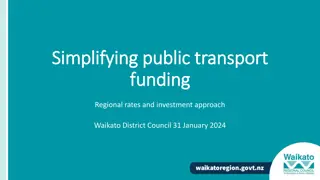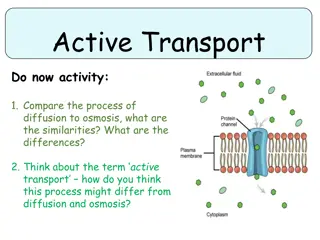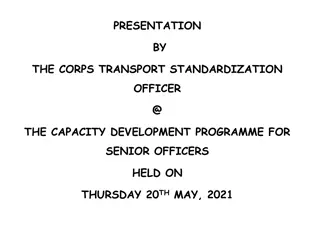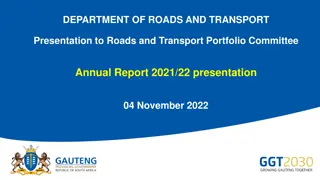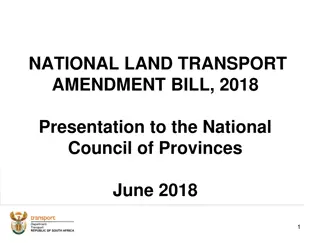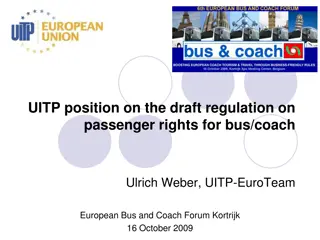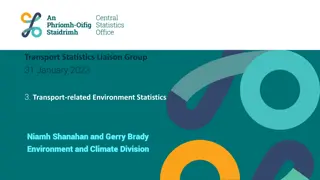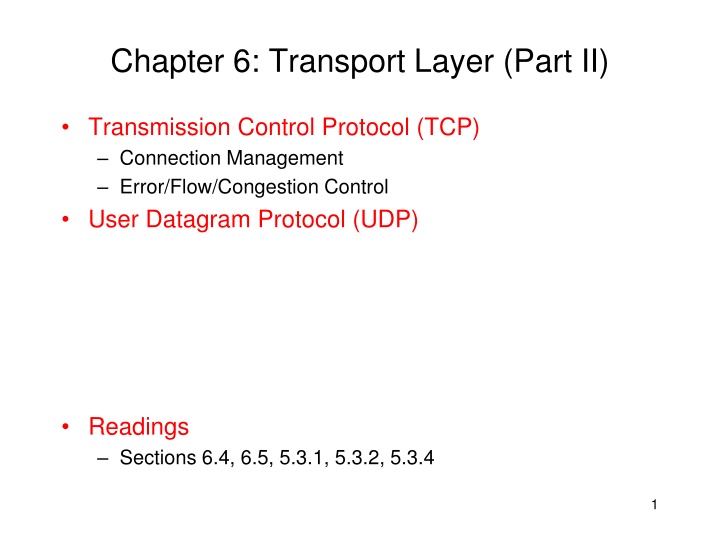
TCP Connection Management: Establishing and Closing Connections
Learn about Transmission Control Protocol (TCP) connection management including the three-way handshake for establishing connections and the process for closing connections. Understand the key components of TCP segments and how data is exchanged between sender and receiver.
Download Presentation

Please find below an Image/Link to download the presentation.
The content on the website is provided AS IS for your information and personal use only. It may not be sold, licensed, or shared on other websites without obtaining consent from the author. If you encounter any issues during the download, it is possible that the publisher has removed the file from their server.
You are allowed to download the files provided on this website for personal or commercial use, subject to the condition that they are used lawfully. All files are the property of their respective owners.
The content on the website is provided AS IS for your information and personal use only. It may not be sold, licensed, or shared on other websites without obtaining consent from the author.
E N D
Presentation Transcript
Chapter 6: Transport Layer (Part II) Transmission Control Protocol (TCP) Connection Management Error/Flow/Congestion Control User Datagram Protocol (UDP) Readings Sections 6.4, 6.5, 5.3.1, 5.3.2, 5.3.4 1
TCP: Overview point-to-point: one sender, one receiver reliable, in-order byte steam: no message boundaries pipelined: TCP congestion and flow control set window size send & receive buffers full duplex data: bi-directional data flow in same connection MSS: maximum segment size connection-oriented: handshaking (exchange of control msgs) init s sender, receiver state before data exchange flow controlled: sender will not overwhelm receiver application writes data application reads data socket door socket door TCP TCP send buffer receive buffer segment 2
TCP Segment Structure 32 bits URG: urgent data (generally not used) counting by bytes of data (not segments!) source port # sequence number acknowledgement number S R P A U len used dest port # ACK: ACK # valid head not rcvr window size ptr urgent data F PSH: push data now (generally not used) # bytes rcvr willing to accept checksum RST, SYN, FIN: connection estab (setup, teardown commands) Options (variable length) application data (variable length) Internet checksum (as in UDP) 3
TCP Connection Management: establish a connection Three-way handshake: TCP sender, receiver establish connection before exchanging data segments initialize TCP variables: seq. #s buffers, flow control info Step 1: client end system sends TCP SYN control segment to server specifies initial seq # Step 2: server end system receives SYN, replies with SYNACK control segment client: connection initiator ACKs received SYN allocates buffers specifies server receiver initial seq. # Step 3: client replies with an ACK segment server: contacted by client 4
TCP Connection Management: close a connection client server Modified three-way handshake: close client closes socket: Step 1: client end system sends TCP FIN control segment to server close Step 2: server receives FIN, replies with ACK. Closes connection, sends FIN. closed timed wait Step 3: client receives FIN, replies with ACK. Enters timed wait - will respond with ACK to received FINs Socket programming interface close() vs shutdown() Step 4: server, receives ACK. Connection closed. 5
Initial state TCP connection Management Finite state machine CLOSED Application.: passive pening Send: --- Send timeout: RST LISTEN Passive opening Receive: SYN send: SYN, ACK Simultanous opening SYN_RECV SYN_SENT Application: close or timeout Application: close Send: FIN Passive close ESTABLISHED Data transmission CLOSE_WAIT Simultanous close Application: close Send: FIN Receive: FIN Send: ACK CLOSING FIN_WAIT_1 Receive: ACK Send: --- Receive: ACK Send: --- Receive: ACK Send: --- LAST_ACK FIN_WAIT_2 TIME_WAIT Receive: FIN Send: ACK Active close 2 MSL timeout MSL: max. segment life 6
TCP Seq. #s and ACKs Host B Host A Seq. # s: byte stream number of first byte in segment s data ACKs: seq # of next byte expected from other side cumulative ACK User types C host ACKs receipt of C , echoes back C host ACKs receipt of echoed C time simple telnet scenario 7
TCP SYN/FIN Sequence # TCP SYN/FIN packets consume one sequence number For simplification, seq # counts pkts numbers in the example In reality, it is byte counts server client 8
TCP data reliable transmission Theoretically, for every packet sent for which the sender expects an ACK, A timer is started What is the timeout duration? When timer expires, this packet retransmitted This applies to both data packets and control packets SYN and FIN Note that ACK is cumulative Receiver Accept out-of-order packets Respond by acking last pkt received in order So, is TCP using Go-Back-N or Selective Repeat? Hybrid, more like GBN 9
TCP: Timeout and retransmission scenarios Host A Host B Host A Host B Seq=92 timeout Seq=100 timeout timeout X loss time time lost ACK scenario premature timeout, cumulative ACKs 10
TCP Round Trip Time and Timeout Q: how to estimate RTT? SampleRTT: measured time from segment transmission until ACK receipt ignore retransmissions, cumulatively ACKed segments SampleRTT will vary, want estimated RTT smoother use several recent measurements, not just current SampleRTT Q: how to set TCP timeout value? longer than RTT note: RTT will vary too short: premature timeout unnecessary retransmissions too long: slow reaction to segment loss 11
TCP Round Trip Time and Timeout EstimatedRTT = (1-x)*EstimatedRTT + x*SampleRTT Exponential weighted moving average (EWMA) influence of given sample decreases exponentially fast typical value of x: 0.1 Setting the timeout EstimtedRTTplus safety margin large variation in EstimatedRTT larger safety margin Timeout = EstimatedRTT + 4*Deviation Deviation = (1-x)*Deviation + x*|SampleRTT-EstimatedRTT| 12
TCP RTT and Timeout (Contd) What happens when a timer expires? Exponential backoff: double the Timeout value An upper limit is also suggested (60 seconds) That is, when a timer expires, we do not use the above formulas to compute the timeout value for TCP How about the timeout value for the first packet? It should be sufficient large 3 seconds recommended in RFC1122 13
Flow/Congestion Control Sometimes sender shouldn t send a pkt whenever its ready Receiver not ready (e.g., buffers full) Avoid congestion Sender transmits smoothly to avoid temporary network overloads React to congestion Many unACK ed pkts, may mean long end-end delays, congested networks Network itself may provide sender with congestion indication 14
TCP Flow Control flow control receiver: explicitly informs sender of (dynamically changing) amount of free buffer space RcvWindow field in TCP segment sender: keeps the amount of transmitted, unACKed data less than most recently received RcvWindow sender won t overrun receiver s buffers by transmitting too much, too fast RcvBuffer= size of TCP Receive Buffer RcvWindow = amount of spare room in Buffer receiver buffering 15
What is Congestion? Informally: too many sources sending too much data too fast for networkto handle Different from flow control! Manifestations at the end points: First symptom: long delays (long queuing delay in router buffers) Final symptom: Lost packets (buffer overflow at routers, packets dropped) 16
Effects of Retransmission on Congestion Ideal case Every packet delivered successfully until capacity Beyond capacity: deliver packets at capacity rate Reality As offered load increases, more packets lost More retransmissions more traffic more losses In face of loss, or long end-end delay Retransmissions can make things worse Decreasing rate of transmission Increases overall throughput 17
Congestion: Moral of the Story When losses occur Back off, don t aggressively retransmit Issue of fairness Social versus individual good What about greedy senders who don t back off? 18
Taxonomy of Congestion Control Open-Loop (avoidance) Make sure congestion doesn t occur Design and provision the network to avoid congestion Closed-Loop (reactive) Monitor, detect and react to congestion Based on the concept of feedback loop Hybrid Avoidance at a slower time scale Reaction at a faster time scale 19
Closed-Loop Congestion Control Explicit network tells source its current rate Better control but more overhead Implicit End point figures out rate by observing network Less overhead but limited control Ideally overhead of implicit with effectiveness of explicit 21
Closed-Loop Congestion Control Window-based vs Rate-based Window-based: No. of pkts sent limited by a window Rate-based: Packets to be sent controlled by a rate Fine-grained timer needed No coupling of flow and error control Hop-by-Hop vs End-to-End Hop-by-Hop: done at every link Simple, better control but more overhead End-to-End: sender matches all the servers on its path 22
Approaches towards Congestion Control Two broad approaches towards congestion control: End-end congestion control: no explicit feedback from network congestion inferred from end-system observed loss, delay approach taken by TCP Network-assisted congestion control: routers provide feedback to end systems single bit indicating congestion (TCP/IP ECN, SNA DECbit, ATM) explicit rate sender should send at 23
TCP Congestion Control Idea Each source determines network capacity for itself Uses implicit feedback, adaptive congestion window ACKs pace transmission (self-clocking) Challenge Determining the available capacity in the first place Adjusting to changes in the available capacity 24
Additive Increase/Multiplicative Decrease Objective: Adjust to changes in available capacity A state variable per connection: CongWin Limit how much data source has is in transit MaxWin = MIN(RcvWindow, CongWin) Algorithm Increase CongWin when congestion goes down (no losses) Increment CongWin by 1 pkt per RTT (linear increase) Decrease CongWin when congestion goes up (timeout) Divide CongWin by 2 (multiplicative decrease) 25
TCP Congestion Control Window-based, implicit, end-end control Transmission rate limited by congestion window size, Congwin, over segments: Congwin w segments, each with MSS bytes sent in one RTT: w * MSS RTT throughput = Bytes/sec 26
TCP Congestion Control probing for usable bandwidth: ideally: transmit as fast as possible (Congwin as large as possible) without loss increaseCongwin until loss (congestion) loss: decreaseCongwin, then begin probing (increasing) again two phases slow start congestion avoidance important variables: Congwin threshold: defines threshold between slow start phase and congestion avoidance phase 27
Why Slow Start? Objective Determine the available capacity in the first place Idea Begin with congestion window = 1 pkt Double congestion window each RTT Increment by 1 packet for each ack Exponential growth but slower than one blast Used when First starting connection Connection goes dead waiting for a timeout 28
TCP Slowstart Host A Host B Slowstart algorithm RTT initialize: Congwin = 1 for (each segment ACKed) Congwin++ until (loss event OR CongWin > threshold) exponential increase (per RTT) in window size (not so slow!) loss event: timeout (Tahoe TCP) and/or or three duplicate ACKs (Reno TCP) time 29
TCP Congestion Avoidance Congestion avoidance /* slowstart is over */ /* Congwin > threshold */ Until (loss event) { every w segments ACKed: Congwin++ } threshold = Congwin/2 Congwin = 1 perform slowstart 30
Fast Retransmit/Fast Recovery Coarse-grain TCP timeouts lead to idle periods Fast Retransmit Use duplicate acks to trigger retransmission Retransmit after three duplicate acks instead of waiting for timer to expire Fast Recovery Remove the slow start phase Go directly to half the last successful CongWin 31
TCP Fairness Fairness goal: if N TCP sessions share same bottleneck link, each should get 1/N of link capacity TCP connection 1 bottleneck router capacity R TCP connection 2 AIMD makes TCP flows roughly fair (bias towards flows with short RTT). 32
Dealing with Greedy Senders Scheduling and dropping policies at routers First-in-first-out (FIFO) with tail drop Greedy sender can capture large share of capacity Solutions? Fair Queuing Separate queue for each flow Schedule them in a round-robin fashion When a flow s queue fills up, only its packets are dropped Insulates well-behaved from ill-behaved flows Random early detection (RED) 33
More on TCP Deferred acknowledgements Piggybacking for a free ride Deferred transmissions Nagle s algorithm TCP over wireless 34
Connectionless Service and UDP User datagram protocol Unreliable, connectionless No connection management Does little besides Encapsulating application data with UDP header Multiplexing application processes Desirable for: Short transactions, avoiding overhead of establishing/tearing down a connection DNS, time, etc Applications withstanding packet losses but normally not delay Real-time audio/video 35
UDP packet format 0 15 16 31 Source port Destination port UDP length UDP checksum Payload (if any) UDP packet format 36
UDP packet header Source port number Destination port number UDP length Including both header and payload of UDP Checksum Covering both header and payload 37

